Ecatepec de Morelos
Ecatepec (Spanish: [ekateˈpek] (![]()
Ecatepec de Morelos | |
|---|---|
City & Municipality | |
| Ecatepec de Morelos | |
 Seal | |
| Motto(s): Autonomía Unión Trabajo (Autonomy Union Work) | |
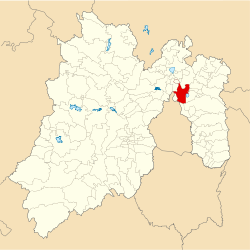 Location of Ecatepec in the State of Mexico | |
| Coordinates: 19°36′35″N 99°03′36″W | |
| Country | |
| State | |
| Metro area | Greater Mexico City |
| Municipal Status | October 13, 1877[1] |
| Municipal Seat | San Cristóbal Ecatepec |
| Government | |
| • Type | Ayuntamiento |
| • Municipal President | Fernando Vilchis Contreras (2019-2021) |
| Area | |
| • Total | 160.17 km2 (61.84 sq mi) |
| • Water | 0.00 km2 (0.00 sq mi) |
| Elevation (of seat) | 2,250 m (7,380 ft) |
| Population (2010 Census) | |
| • Total | 1,656,107 |
| Time zone | UTC−6 (CST) |
| • Summer (DST) | UTC−5 (CDT) |
| Postal code (of seat) | 55000 |
| Area code(s) | 55 |
| Demonym | Ecatepequense |
| Website | Official website (in Spanish) |
The name "Ecatepec" is derived from Nahuatl, and means "windy hill" or "hill devoted to Ehecatl." It was also an alternative name or invocation to Quetzalcoatl.[4] "Morelos" is the last name of José María Morelos, a hero of the Mexican War of Independence.
The Mexico City metro subway system was extended into Ecatepec.
"San Cristóbal" (Saint Christopher) is the city's patron saint. His feast day is celebrated on July 25 each year.[4]
Points of interest include the newest Catholic Cathedral in Mexico, Sagrado Corazón de Jesús, several colonial era churches and the colonel edifice :"Casa de los Virreyes".[4]
Geography
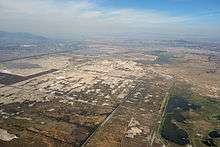
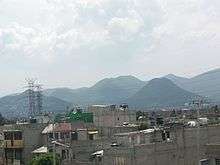
The location of the municipality is north of Mexico City, and is located in the low extreme geographical coordinates of Greenwich, north latitude 19º29'23" minimum, 19º40'28" maximum, west longitude 98°58'30" minimum, 99°08'35" maximum.[5]
The town of San Cristóbal Ecatepec, a municipal seat, has governing jurisdiction over the following communities: San Pedro Xoloxtoc, Tulpetlac, Chiconautla, Ciudad Azteca and Villa de Aragón. The total municipality extends 157.34 km2 and borders with the municipalities of Tlalnepantla de Baz, Tecámac, Coacalco de Berriozábal, Jaltenco, Acolman, Texcoco, Atenco, Nezahualcóyotl and Mexico City (Gustavo A. Madero). The area of this municipality is 155 km² (59.85 sq mi).[6]
The human settlements in Ecatepec de Morelos are an elongated valley from the Valley of Mexico to Sierra de Guadalupe.
Flora and fauna
75% of Ecatepec de Morelos municipality is urbanized, on this territory there are no big animals; in the highlands of Sierra de Guadalupe live principally small mammals such as mouse, rabbit, gray squirrel, bat and gopher, birds, such as cenzontle and sparrow. The flora in Sierra de Guadalupe is represented by oyamel pines, oaks, ocote pines, century plants, prickly pears, zacatón (mountain grass) and other.[7]
History

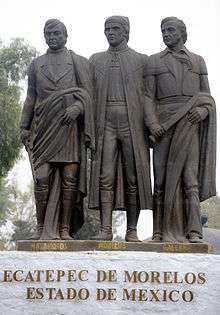
Remains of earliest human inhabitation of the area have been found on the nearby Cerro (Hill) de Ecatepec. The area was initially settled by successive waves of Otomis; however, because of the later arrival of Toltec-Chichimecas that dominated the rest of the Valley of Mexico, this area eventually assimilated to the rest of the Valley, ending with its domination by the Aztec Empire.[6] Ecatepec was an Aztec altepetl or city-state in the Valley of Mexico. From 1428 to 1539, Ecatepec was ruled by a tlatoani (literally "speaker"). The tlatoque (plural of tlatoani) of Ecatepec were closely related to the ruling dynasty of Tenochtitlan.[8] - Chimalpilli I, grandson of Moctezuma I. - Tezozomoc, son of Chimalpopoca. - Matlaccohuatl, whose daughter Teotlalco married Moctezuma II. - Chimalpilli II, son of Ahuitzotl. - Diego de Alvarado Huanitzin, grandson of Axayacatl.
Diego Huanitzin was subsequently made tlatoani of Tenochtitlan by Antonio de Mendoza, viceroy of New Spain.
During the Aztec empire, the Mexicas used the town to control trade routes going north.[4]
Ecatepec was considered an "República de Indios" (Indian Republic) 1560, allowing the village to maintain a certain amount of autonomy and keeping the succession of tlatoanis or chiefs. However, in the first part of the 17th century, this was changed to a mayorship, with the Spanish administrating, along with the communities of Zumpango and Xalostoc.[6]
The municipality was officially created on October 13, 1874.[4] On October 1, 1877, San Cristóbal Ecatepec was declared a village and "de Morelos" was added to its name.[6]
The national hero José María Morelos y Pavón was executed in Ecatepec in 1815 by the Spanish during the Mexican War of Independence. The house in which he was executed is now the Museo Casa de Morelos (Museum House of Morelos). Ecatepec was declared a city on December 1, 1980.[4]
In April 1995, the remains of a mammoth were found in Colonia Ejidos de San Cristóbal, where the ancient lakes of Xaltocan-Ecatepec and Texcoco came together and where the Aztecs build a dam to keep the fresh and salty waters separate. The bones have been tentatively dated to around 10,500 years B.C.[6]
Ecatepec de Morelos had a 2010 census population of 1,656,107 inhabitants, which makes it the most populous municipality in the nation , as well as in the state.
In February 2016, Pope Francis celebrated Mass in the city in front of a crowd of 300,000. The Pope's message was one of encouragement and opposition to the violence and drug trade that permeates the region.[9]
Politics
| Mayor | Time |
|---|---|
| Indalecio Ríos Velázquez | 2016– |
Demography
Almost all of the population (99.934%) lives in its one urban locality, Ecatepec de Morelos, the most populous locality (city) in Mexico except for the Iztapalapa Borough of Mexico City. There are also six rural localities (cities, towns, and villages) in the municipality, half of which reported no population in the 2010 census:[10]
| Populated place | 2010 Census Population |
|---|---|
| San Cristóbal Ecatepec | 1,655,015 |
| Mesa de los Leones | 578 |
| Tierra Blanca Segunda Sección (Ejido Ecatepec) | 480 |
| Vista Hermosa | 34 |
| Banco de Tepetate (La Tepetatera) | 0 |
| Caseta Trece Curva del Diablo | 0 |
| El Tejocote | 0 |
| Total Municipality | 1,656,107 |
Economy

Jumex has its headquarters in the city.[11][12]
Plaza Las Américas shopping mall is located in Ecatepec, in which are located Liverpool, Sears and Suburbia department stores as well as a Walmart.
Transportation
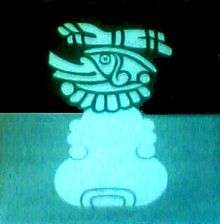
Ecatepec is served by Line B of the Mexico City Metro system, including stations Muzquiz, Ecatepec (a.k.a. Tecnológico), Olímpica, Plaza Aragón, and Ciudad Azteca[13][14]
In 2016, a new transportation system was introduced to Ecatepec's inhabitants: Mexicable. This project is a cable car which main purpose is to help people get around faster (contrary to most cable cars which have tourists as their main users), especially in areas with complicated geography. The idea was originally developed in South America, with Colombia being the first country to add a cable car system, called Metrocable, as part of their metro. The Mexicable, the first cable car constructed in Mexico as a form of public transportation, has a length of almost 5 kilometres (3 miles), 190 cars and it runs the entire line in about 17 minutes.[15]
Ecatepec is located on Fed 85, the Mexico City-Pachuca highway, Fed 57/Fed 57D (Circuito Exterior Mexiquense), and Fed 132 (Ecatepec-Teotihuacán highway).
Sister cities
| City | State | Country | Reference |
|---|---|---|---|
| Caracas | Miranda | ||
| Cuautla | |||
| Guadalupe | [17] | ||
| Guangzhou | |||
| Namyangju | [18] | ||
| San Jose |
References
- "Bando Municipal de Ecatepec de Morelos 2015" (PDF). H. Ayuntamiento de Ecatepec de Morelos 2013-2015. Archived from the original (PDF) on September 23, 2015. Retrieved August 18, 2015.
- "Principales resultados por localidad 2005 (ITER)". Web.archive.org. 13 June 2011. Archived from the original on 13 June 2011. Retrieved 28 August 2017.
- "RESULTADOS DEFINITIVOS DE LA ENCUESTA INTERCENSAL 2015" (PDF). Inegi.org.mx. Retrieved 2017-08-28.
- "Historia de Ecatepec". Ecatepec.com. Retrieved 2008-03-08.
- "Ecatepec de Morelos municipality" (PDF). 3.inegi.org.mx. Archived from the original (PDF) on 2016-05-28. Retrieved 2017-08-28.
- "Enciclopedia de los Municipios de México Estado de Mexico Ecatepec". Archived from the original on 2007-09-30. Retrieved 2008-03-08.
- "Estado de México - Ecatepec". Inafed.gob.mx. Retrieved 28 August 2017.
- Explorations in ethnohistory: Indians of central Mexico in the sixteenth century by H. R. Harvey, Hanns J. Prem
- "Pope Francis warns Mexico City crowd against 'dialogue with the devil'". The Guardian. 14 February 2016.
- 2010 census tables: INEGI Archived May 2, 2013, at the Wayback Machine
- "Contacto Archived 2014-02-09 at the Wayback Machine" (Archive). Jumex. Retrieved on May 27, 2014. "Antigua Carretera Mexico Pachuca, Km 12.5 Xalostoc Estado De Mexico, CP 55340"
- "Aviso de privacidad" (Archive). Jumex. Retrieved on May 27, 2014. "[...]GRUPO JUMEX, S.A. de C.V., con domicilio en Carretera México-Pachuca KM 12.5, Colonia Rústica Xalostoc, Ecatepec de Morelos, Estado de México, C.P. 55340, México"
- "Ecatepec". Metro.df.gob.mx (in Spanish). Archived from the original on 25 August 2012. Retrieved 6 August 2011.
- Archambault, Richard. "Ecatepec » Mexico City Metro System". Mexicometro.org. Retrieved 6 August 2011.
- "President inaugurates cable car system". Mexico News Daily. Retrieved 1 February 2017.
- "The Medical Blog". Multilingualarchive.com. Archived from the original on 11 February 2012. Retrieved 28 August 2017.
- "Archived copy". Archived from the original on 2012-04-29. Retrieved 2012-03-22.CS1 maint: archived copy as title (link)
- "Organización Editorial Mexicana". Oem.com.mx. Retrieved 28 August 2017.
External links
| Wikimedia Commons has media related to Ecatepec de Morelos Municipality. |
- (in Spanish) Portal of Ecatepec de Morelos
- (in Spanish) Ayuntamiento Constitucional de Ecatepec de Morelos Official website
